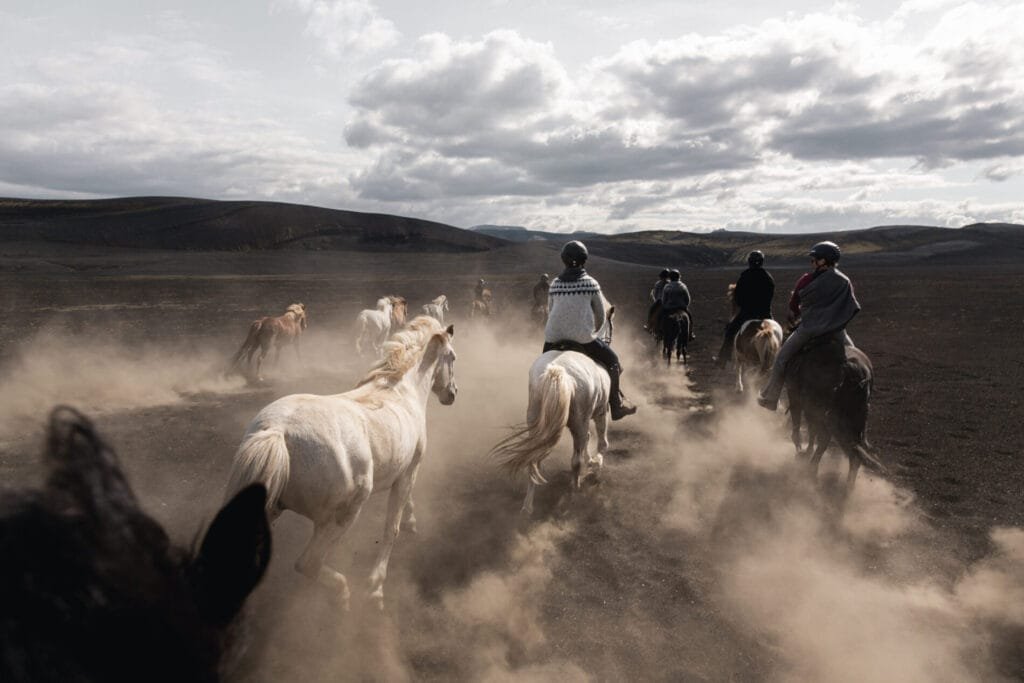Encountering a dog while horseback riding can be a frightening experience, especially if the dog is aggressive.
Dogs, especially those that are not leashed or properly trained, may see a horse as a threat or may become excited and chase after the rider. Knowing how to react when you’re on horseback can make all the difference in avoiding an attack and staying safe. Here are some practical tips for preventing dog attacks while horseback riding:
1. Stay Calm and Confident
The first and most important thing to remember is to stay calm. Horses are highly sensitive animals and can easily pick up on their rider’s emotions. If you panic or become anxious, your horse may become unsettled, which could make the situation worse.
- Keep your body relaxed and use calming commands with your horse if it becomes anxious.
- Breathe deeply to stay calm, and try to maintain control of your horse.
Dogs often attack or chase because they sense fear or uncertainty, so projecting calm confidence will help prevent your horse from reacting in a panic.
2. Avoid Aggressive Dogs from the Start
The best way to avoid a dog attack is to prevent an encounter altogether. Be aware of your surroundings and stay alert to possible dog threats on your route.
- Stay on well-maintained trails or roads: Avoid areas where dogs are known to roam freely, especially if you know the area has aggressive dogs.
- Look for signs of dogs ahead: If you see dogs off-leash or notice any signs indicating a dog-friendly area, be cautious and prepare yourself.
- Don’t approach loose dogs: If you see a dog in the distance, avoid riding closer to it, especially if it seems to be wandering off-leash or showing any signs of aggression.
3. Use Deterrents to Keep Dogs at Bay
If you regularly ride in areas where you might encounter loose dogs, consider carrying items that can help deter an aggressive dog.
- Carrying a whistle or horn: A loud sound, like a whistle or horn, can startle a dog and deter it from approaching. Horses are often used to loud noises, so this won’t usually scare them, but it could deter the dog from getting closer.
- Pepper spray or dog repellent: While this should be used as a last resort, carrying dog-specific pepper spray or an aerosol dog repellent can be effective in warding off aggressive dogs. Be sure to use it only if the dog is attacking or posing a direct threat.
Always check your local laws, as using some deterrents may be regulated in certain areas.
4. Use Your Horse’s Size to Your Advantage
Horses are large, strong animals, and most dogs will hesitate before attacking or getting too close to a horse’s hooves.
- Control your horse: If a dog approaches, calmly guide your horse to stand tall, and let the dog see the horse’s size and strength.
- Turn your horse sideways to present a larger, more intimidating profile. The horse’s size and strength may be enough to dissuade the dog from coming any closer.
Most dogs instinctively back away when faced with the large, powerful presence of a horse.
5. Know How to Respond If a Dog Approaches Aggressively
Despite your best efforts, an aggressive dog may approach your horse. Knowing how to handle this situation can prevent harm to both you and your horse.
- Maintain control of your horse: Try to stay as still and calm as possible. If your horse is frightened, give it time to calm down and reassure it with your voice and hands. Avoid any sudden movements.
- Create distance: Try to move away slowly if possible. Horses can move quickly, so if your horse is calm enough, gently guide it to step away from the dog.
- Don’t try to chase the dog away: Never get off your horse to confront an aggressive dog. A dog that feels cornered or threatened may attack, so it’s best to stay on the horse, which offers you height and protection.
- Use your horse’s body: If a dog does attack, you can position your horse’s body between you and the dog. The horse’s hooves can help protect you from an aggressive dog if necessary.
6. Avoid Riding in Areas Known for Aggressive Dogs
Certain areas may have a higher risk of encountering aggressive dogs. Be aware of where you’re riding and avoid routes where you know there have been reports of loose or aggressive dogs.
- Ride with a group: Riding with others can provide an added layer of safety in case of an encounter with a dog. Dogs may be less likely to approach a group of horses than a single rider.
- Let the landowner know: If you encounter loose dogs on public or private land, consider informing the landowner or local authorities so they can address the issue. This helps reduce the risk for other riders in the future.
7. Train Your Horse to Handle Dogs
Some horses are naturally more fearful of dogs, especially if they haven’t been exposed to them often. Training your horse to be comfortable with dogs at a safe distance can help prevent panic in an actual encounter.
- Desensitize your horse: Spend time training your horse to remain calm around dogs. Start with a controlled situation, like introducing them to a calm dog at a distance, and gradually decrease the distance as your horse becomes more comfortable.
- Practice with distractions: If possible, work with your horse in an environment where dogs are present (but not threatening) to help your horse learn to stay calm in these situations.
Final Thoughts
While encountering dogs on horseback can be unsettling, staying calm, prepared, and aware of your surroundings can significantly reduce the risk of an attack. With proper precautions, you and your horse can handle these situations safely. Always remember that your horse’s safety and your own are the top priority—trust in your horse’s instincts and use the tools and strategies available to keep both of you safe.




